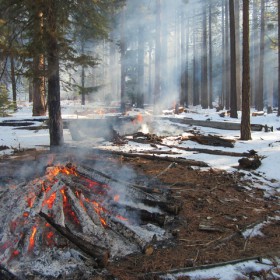Published: Nov 05, 2014

South Lake Tahoe, Calif. – You’ve walked by them, biked past them, and maybe even seen them on empty lots – what are those random piles of wood? The piles are the first half of a two-step process used by Lake Tahoe Basin agencies to reduce hazardous fuels, provide community protection, and improve forest health.
Throughout the summer, agency crews generate piles of slash during fuel reduction activities. Then, from late fall through early spring, during specific weather conditions and under careful supervision, these agencies employ a prescribed burn technique called pile burning to remove the material.
Fire is natural to the Lake Tahoe Basin’s environment. Lightning strikes naturally ignite wildfires which clear brush and dead trees from the forest floor. Decades of active fire suppression have created a tinder box of densely packed trees which pose a higher risk of catastrophic wildfire.
By combining manual removal of vegetation with prescribed fire, fire managers at Lake Tahoe are returning the forest to a healthier open condition and protecting Lake Tahoe’s residents, visitors and natural resources. Prescribed burns reduce the risk of large, damaging wildfires such as the Angora Fire and King Fire, and improve the growing conditions of native plant and wildlife species.
All agencies take prescribed burns very seriously. Prescribed fires, including both pile burns and low-intensity understory burns, can only be conducted when the precise weather conditions exist where the fuels will burn quickly and cleanly producing the least amount of smoke possible. In fact, prescribed burns produce significantly less smoke than wildfires.
Prior to burning, agencies will calculate how many airborne particulates will be produced by a prescribed burn based on the type of vegetation, topography, and number of acres that will be burned. Air quality impacts are regulated by the state in which the burn is to occur; the state determines whether or not prescribed burning will be allowed on a given day, based on atmospheric conditions. If the necessary conditions are not met, the fire will be postponed until conditions “come into prescription.”
Some fires are left unattended following the ignition and initial burn period, if the responsible agency determines that they do not require constant staffing. If conditions allow, prescribed fires will not be extinguished. Agencies closely monitor weather and provide regular patrols of the area.
Fire also looks bigger at night. You will see glowing in the forest and some individual trees or logs with flames. This is normal. Smoke is a natural byproduct of the burns and may last for several days.
Individuals are encouraged to contact the U.S. Forest Service, Lake Tahoe Basin Management Unit at pa_ltbmu@fs.fed.us so that they can be placed on a Tahoe Fire and Fuels Team list and be contacted prior to any burning in their area. You can also stay tuned for weekly emails from the Tahoe Fire and Fuels Team about where agencies will be burning in the Basin.
If you have a low tolerance for smoke, these tips may help you reduce your exposure:
- Stay indoors as much as possible, especially seniors and children. Avoid physical exertion.
- Close windows, doors, and outside vents when it is smoky. Use a fan or air conditioner to re-circulate the air. Ventilate your home and work place during periods when it is least smoky.
- Drink lots of water, eat a balanced diet and get adequate rest. Good health strengthens your immune system.
- Be diligent about taking medicines prescribed by your doctor if you have pre-existing respiratory problems.
- Consult your physician, if, after following these guidelines, you still experience discomfort while breathing.
###
About the Tahoe Fire and Fuels Team
The Tahoe Fire and Fuels Team (TFFT) consists of representatives of Tahoe Basin fire agencies, Cal Fire, Nevada Division of Forestry and related state agencies, the Tahoe Regional Planning Agency, the USDA Forest Service, conservation districts from both states, the California Tahoe Conservancy and the Lahontan Regional Water Quality Control Board. Our Mission is to protect lives, property and the environment within the Lake Tahoe Basin from wildfire by implementing prioritized fuels reduction projects and educating the public on becoming a Fire Adapted Community.
For more information, visit tahoe.livingwithfire.info.

